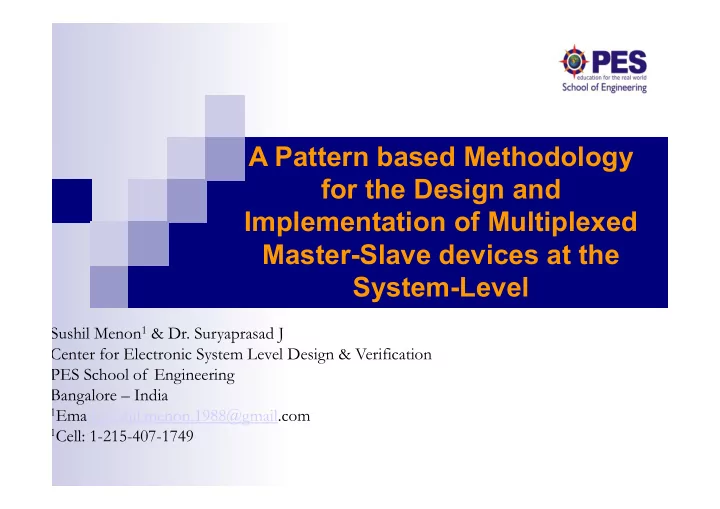

A Pattern based Methodology for the Design and Implementation of Multiplexed Master-Slave devices at the System-Level Sushil Menon 1 & Dr. Suryaprasad J Center for Electronic System Level Design & Verification PES School of Engineering Bangalore – India 1 Email: sushil.menon.1988@gmail.com 1 Cell: 1-215-407-1749
Outline ■ IP Modules and their role in Virtual Prototyping ■ Current technology/methodology ■ Proposition of a “ Design Pattern ” based methodology ● The “ Master-Bus-Slave/Master-Bus-Slave ” Design Pattern ■ Modeling an L2Cache IP module using proposed methodology ■ Conclusion 2
Virtual Prototyping and IP Modules Figure: Virtio VPXS Virtual Platform - Intel XScale core Advantages of IP-based Virtual Prototyping: � “ Plug-and-Play ” IPs allow easy Virtual Prototyping � “ Parameterized IPs ” allow architectural exploration 3
Current Technology/Methodology ■ Industry focus more on RTL models, less on TLM models ● RTL more suited for physical synthesis as compared to TLM ■ However, RTL yields lower simulation speed and makes architectural exploration a nightmare! ● Too many details! Too many signals/pins, cycle accurate designs. ● Many component manufacturers, increased inter-component interface obscurity, hence increased integration difficulty! ■ Thus, TLM more suitable for Virtual Prototyping. ● Increased Level of Abstraction, simplified inter-component interfaces, reduced details, thus resulting in faster simulation! ■ ESL and SystemC are starting to become prevalent in the Electronic System Design industry. 4
Modeling IPs using “ Design Patterns ” ■ Design Patterns – are standard architectures, targeted at specific problem scenarios. ● Advantage: re-usability of pre-defined and tested architectural solutions ● Example: “ Master-Bus-Slave ” Design Pattern ■ Usually: Master – Processor, Bus – System Bus, Slave – Peripherals 5
The “ Master-Bus-Slave/Master-Bus- Slave ” Design Pattern ■ Usually adopted by “ Multiplexed Master-Slave ” components ● Example: L2Caches, DMA Controllers etc. 6
Modeling an L2Cache IP Module at Transaction Level ■ L2Cache – small, high-speed memory between Processor and Memory, used to improve system performance ■ Goal: Showcase proposed Methodology through the design of a L2Cache IP Module using the “ Master-Bus-Slave/Master-Bus-Slave ” Design Pattern ● L2Cache IP Module is designed at Transaction Level ■ Phases in proposed Methodology: ● Phase 1: Elicitation of Requirements ● Phase 2: Deriving Model Block Diagram and State Machines ● Phase 3: Implementing the L2Cache Structure & Derived State Machines using SystemC ● Phase 4: Implementing the System Test-bench ● Phase 5: Extending the L2Cache for Parameterization ● Phase 6: Verification of the L2Cache IP Module 7
Phase 1 – Elicitation of Requirements ■ Data was collected from the technical specification of the “ Motorola MPC2605 L2Cache ” ■ Requirements of the module are captured and illustrated in the following Use-Case diagram 8
Phase 2 – Deriving Model Block Diagram and State Machines ■ Convert textual information from technical spec into a suitable Model Block Diagram and Hierarchical State Machines ■ Hierarchical State Machines - State Machines that contain states that are sub-state machines (denoted by * in state) ● Provides a highly modular framework 9
Phase 3.1 – Implementing the L2Cache Structure using SystemC 10
Phase 3.1 – Implementing the L2Cache Structure using SystemC 11
Phase 3.1 – Implementing the L2Cache Structure using SystemC 12
Phase 3.2 – Implementing the Derived State Machines using SystemC 13
Phase 3.2 – Implementing the Derived State Machines using SystemC 14
Phase 3.2 – Implementing the Derived State Machines using SystemC 15
Phase 3.2 – Implementing the Derived State Machines using SystemC 16
Phase 3.2 – Implementing the Derived State Machines using SystemC 17
Phase 4 – Implementing the System Test-Bench NOTE: Since all Modules are at TLM, every Transaction executes in 1 18 Clock-Cycle!!
Phase 4 – Implementing the System Test-Bench NOTE: Since all Modules are at TLM, every Transaction executes in 1 19 Clock-Cycle!!
Phase 5 – Extending the L2Cache for Parameterization ■ Existing State Machines are suitably re-modeled according to changes occurring due to selection of a different parameter ■ Changes in State Machines are then translated into SystemC code by encapsulating them around conditional compilation directives 20
Phase 6 – Verification of the L2Cache IP Module ■ Implement a series of transactions, initiated by Processor, that trigger the appropriate functionality in L2Cache 21
Phase 6 – Verification of the L2Cache IP Module ■ Implement a series of transactions, initiated by Processor, that trigger the appropriate functionality in L2Cache Verification of "Direct-Mapping" mode 22
Conclusion ■ Success of Virtual Prototyping depends on large warehouses of Pre-Designed, Developed and Parameterizable IP Modules ■ Generation of IP Modules is accelerated through the usage of a “ Systematic ” and “ Efficient ” Methodology ■ Proposed Methodology is: ● Efficient – Usage of readily available “ Design Patterns ” that are pre-defined and tested ● Systematic – Seamless flow between successive phases in the Methodology 23
Thank You! ! Questions/Concerns? 24
Recommend
More recommend